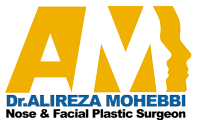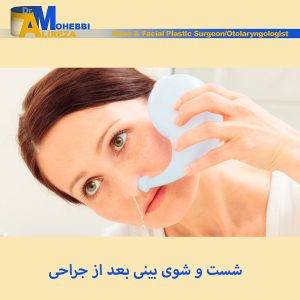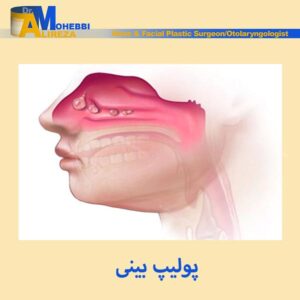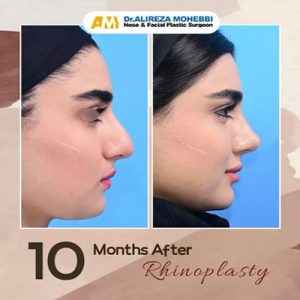Alireza Mohebbi, MD; Framarz Memari, MD; Saleh Mohebbi, MD. Headache 2010;50:242-248
Background
Man types of sinonasal headaches are not well defined or specified. These headache types, however,are well known.
In 1980, Morgenstein and Krieger described “middle turbinate headache syndrome.” They sug-gested referred pain could result from contact between the middle turbinate and septum and indi-cated that turbinectomy and septoplasty had cured the majority of their patients.1
Later, in 1988, Stammberger and Wolf des-cribed contact point headache pathophysiology. 2,3
Seemingly, the presence of contact points in various parts of the nasal cavity prompted different types of headaches in the trigeminovascular system and caused the release of substance P (SP) mediates pain impulses.2,3
Diagnostic criteria provided in the 2nd International Classification of Headache Disorders stipulate a separate classification for sinonasal head- aches originating from migraine headaches since they require different treatments.3
The simultaneous presence of sinonasal and migraine headaches and the overlapping of their symptoms and triggering elements does, however, require further research. In addition, there are reports of curing migraine headaches with endonasal surgery that need more clarification as to which group of patients may benefit from surgery.
Contact points between the lateral parts of the nasal wall and septum could cause various headaches and facial pain through the release of SP and its transfer via afferent C fibers to the cortex. These headaches sometimes appear very similar to classic headaches such as migraine, cluster and tension head- aches. Contact points could be between the septumand any of the lower, middle, or superior turbinates and even ethmoid regions. 2
Observations in humans also support the role of calcitonin gene-related peptide (CGRP) in the pathophysiology of headache. Activated meningeal nociceptors release CGRP from their centrally projecting nerve endings within the trigeminal nucleus caudalis, then via second neurons, cause vasodilation, mast cell degranulation, and plasma extravasation, mediating the perception of headache pain. 4
OBJECTIVE
This study aimed to evaluate the level of feasibil-ity and effectiveness of endonasal endoscopic sinona-sal surgery on resolving headaches that may be triggered by contact points.
METHODS
This research study was performed at the Hazrat-e RasoulAkramMedical Center, IranUniver-sity ofMedical Sciences (IUMS), over a 4-year period from October 2003 to August 2007. The study was conducted in a prospective, quasi-experimental and non-randomized manner.
Staff adhered to several criteria for patient selec-tion. We considered patients based on their history and description of individual symptoms as to whether their headaches were chronic or acute.We also con-sidered their history of chronic intermittent pain in the head and face.Patients were admitted to the study if signs of inflammation were absent upon examina-tion and this absence was confirmed by computed tomography (CT) of the nose and sinus. We also included patients who had failed to respond to previ-ous treatments and then sought positive evidence of contact points by endoscopy, rhinoscopy, CT scan, assessing their response to local anesthetic tests or a combination of several of these diagnostic criteria.
We finally performed a thorough evaluation and obtained appropriate consultations and then excluded those patients in which obvious causes of headaches due to ophthalmic, dental, neurological, and/or internal reasons were found.The preoperative headache intensity were recorded based on a 10-point visual analog scale (VAS) in which 0 symbolizes the absence of headache and 10 represents the most intense pain of all.
All patients underwent rhinoscopic and endo-scopic examinations as well as coronal paranasal diagnostic CT scans. We examined patients who visited in the acute phase of headache, and others who did not visit at headache time, so the tetracaine test was not done. It was then applied to the contact point under direct vision by the examining doctor. The response was evaluated 30 seconds after applica-tion.A positive response was defined as at least 50% decrease in pain severity.
For further analysis, we then classified and grouped the patients into 4 diagnostic categories.
Group 1 comprised the individuals in whom we iden-tified contact points solely by physical examination and although the CT scans did not reveal contact points, nasal endoscopy did.
Group 2 consisted of patients who in addition to their positive examination responded positively to topical application of tetra-caine and naphazoline.Their CT scans were negative.
Group 3 included those individuals who showed posi-tive evidence of contact points both on their CT scan and in their examination and failed anesthetic test.
Group 4 patients were those who had all 3 diagnostic criteria, ie, positive physical examination, positive response to application of topical anesthetic agents, and positive CT scans.
All procedures were performed by using endo-scopic methods. In cases where severe deviation of the septum was obvious, surgeons performed the cor- rective procedures using standard methods. Patients used antibiotics and analgesics for up to 5 days postoperatively.
Postoperative follow-up was done 2-4 weeks after surgery.A postoperative CT scan was only performed in non-responders to discover the exact cause of failure. We then analyzed patient pre- and post- operativeVAS scores using a paired t-test and utilized analysis of variance tests and Statistical Package for Social Sciences (SPSS) for statistical comparison and evaluation within and between groups. For this study, P < .05 was considered statistically significant.
RESULTS
We initially selected 47 patients who had perior-bital pain particularly at the medial canthus, frontal and zygomatic regions for the study. Eleven patients were lost during the follow-up period for various reasons leaving 36 patients for follow-up. Inclusion to the study, follow-up and analysis were done after obtaining informative consent. The patient was then followed up for 20-36 months with an average follow-up of 30 months.
The headache history of 36 patients ranged from a 3-11-year span with an average duration of 5.5 years. The average age of the patients was 37 1.52, with an age range of 19-57 years. The patient sample consisted of 24 men (66%) and 12 women (34%).
Ten patients (27.8%) comprised group 1. Seven patients (19.5%) made up group 2. Fourteen (38.9%) patients were in group 3 while 5 patients (13.9%) were included in group 4. In all groups, the preopera-tive severity of headache was at a similar level (P < .05) making comparison between the groups possible. Table 1 illustrates relevant demographic data and pre- to post-operative VAS pain severity scores confirming patient response to surgery.

In 17 patients, tetracaine and naphazoline tests were done. Twelve responded positively in groups 2 and 4, and 5 negatively in groups 1 and 3. Seventeen patients had negative CT scans (groups 1 and 2) while CT scans were positive in 19 cases (groups 3 and 4).
Various surgical procedures utilized were septo-plasty (80%), turbinoplasty (55%), and complete or partial ethmoidectomy (66%). Analysis of variance method and SPSS software were used to record and analyze pre- and post- operative VAS data gathered on the patients and, ultimately, the results are shown in Table 2. For table definition purposes, cure means elimination of pain, improvement denotes a decrease in pain score that is statistically significant, and no or little change indi- cates no statistically significant change in pain score (P > .05).
Patient responses to surgical corrective treat-ment(s) were statistically significant (P = .005) as shown in Figure 1. The overall success rate for improvement of patient pain in our research study was approximately 83%. Complete cure occurred in 11% of the participants and a clear improvement of symptoms appeared in another 72%. Seventeen percent of the cases showed little or no change.

Approximately 50%in group 1 saw improvement in their symptoms postoperatively (P < .05). Group 2 had a 100% improvement in their pain symptoms.
Ninety-three percent of group 3 patients responded positively to their surgical procedure, of which 7% achieved a complete cure and 86%had improvement of symptoms.Group 4 had a 60%cure rate while 40% experienced improvement of symptoms (P < .05).
Postoperative pain intensity and change in pain score showed a statistically significant difference between the first group and the other groups (P = .001) as depicted in Figure 2.
However, there was no significant variation for groups 2, 3, and 4.
Fourteen of the final 36 participants (39%) had been previously diagnosed with migraine headaches and had not responded to conventional treatments before entering the study.
Our colleagues in the IUMS Neurology Department referred 9 of these 14 participants to our clinic.Overall, 9 of our 14migraine headache patients (64% of 14) had significant improvement of symptoms while a cure or complete alleviation of symptoms occurred in 2 of the 9 improved cases (14% of 14). So overall, 9 of the 14 migrainous patients (64%) showed a positive response to corrective surgical treatment.
The results of our 14 migrainous patients within the 36 participants (shown inTable 2) were as follows. In group 1, 2 of 4 patients improved while 2 of 3 patients in group 2 also showed improvement. Five patients were in group 3 (3 improved and 1 of these 3 was cured completely).Of the 2 patients in group 4, 1 improved and 1 was cured.

Fig. 1.—Pre- and postoperative pain intensity and pain inten-
sity decrease as seen in patients with contact points.

Fig. 2.—Postoperative pain intensity difference in different
patient groups with contact points.
DISCUSSION
We have found that some headaches have their origin in the nose and, by correcting this cause in the nose and sinus, we can potentially treat the headache. Our goal was to evaluate the effectiveness of the elimination of these causes. Accordingly, the specific correction of contact points in mucosal tissues within the nasal region could achieve a cure or reduction of headache symptoms. Also, determination of precise diagnostic methods and selection of patients became the focal points of this research study.
Roe in 1888 and Sluder in 1910 described a rhi-nologic pathology that induced pain in head and face. However, in articles appearing in 1942 and 1943; Wolff and McAuliffe investigated and described referred headaches as “referred headaches secondary to nasal pathologic lesions.”3
In 1988, Stammberger and Wolf discussed the pathophysiology of contact point headaches in a pub-lished article and explained how the release of SP in the nasal tissues causes headaches.They described SP as a neuropeptide with potent vasodialating effects that transfers via afferent C fibers secondary to thermal, toxic substances, infection, and/or mechani-cal stimuli that can induce pain.2 Furthermore, Behinet al identify SP as a pain mediator. 5
Abu-Bakra and Jones in their investigation rejected the need for surgical operation when an equal occurrence of contact points exists in individu- als having headaches and those without headaches (4%). They concluded that surgery to remove mucosal contact points did not necessarily make facial pain subside. 6 Jones and Cooney have described mid-facial segment pain as a type of tension headache that primary affects the mid-facial segment.7
For patient selection in various studies, lidocaine and cocaine were used for the anesthetic test. 3,8 However, we used tetracaine by similar mechanism and effect for this test. In many research studies the success rates for surgery to reduce pain in this regard have been variable. Ramadan, 9 Parson and Batra, 10 Clerico et al, 11 Chow, 12 and Morgenstein and Krieger1 have reported 60%, 91%, 79%, 83%, and 89%success rates, respectively.
A review of the literature revealed the majority of the studies had short follow-up periods except for 2 instances. In a study by Welge-Luessen et al pub-lished in 2003 featuring a prolonged follow-up period of about 10 years, the total success rate was reported as 65%.3
However, earlier in 1996, Welge-Luessen et al reported an even higher rate of 85%success rate obtained in a 3-year study conducted on patients with headaches having neurological origins, thus indicating very good results. 13
For this reason, we consider this study to be of relatively long follow-up duration since we had a 20-to 36-month follow-up period with an average of 30 months. To avoid losing patients in a more extensive follow-up period, we choose to collect and analyze the data for this stated time period. In our study, results indicated an improvement rate of 83%includ- ing 11% cure rate and 72% significant improvement. Seventeen percent of the patients did not report sig- nificant improvement; however, no one reported any deterioration. Our result was nearly equal to previ- ously published studies, although we think that the lack of response in some cases was due to failure in contact removal (Fig. 3).
We had the highest success rate in group 4 wherein all criteria were utilized, and we observed a significant decrease in headache severity in groups 2 and 3.Our cure rate of 11%was low and was perhaps due to the lack of a larger sample. In a study by Tosun
et al, 43% and 47%,14 and in a study by Bonchoo, 62.5% and 37.5% cure and improvement rates were noted, respectively. 15

Fig. 3.—Postoperative coronal computed tomography scan of a
patient who experienced no relief of pain. Note remaining
contact point between the superior turbinate and septum.
We believe that more thorough evidence is needed to confirm the presence of contact points.This is critical to improve the chance of surgical success.In this study, we obtained different surgical results in patients who had 3 diagnostic confirmations of contact point in comparison with those who had only 2 findings, but the differences were not significant. However, we insist on recommending medical treat- ment for patients who did not show any specific evi-dence during examination, endoscopy or CT scans as West and Jones did. 16 We also emphasize at least one additional test, either a CT scan or an anesthetic test besides physical examination to attain a more suc- cessful surgical result.
Interestingly, our success rate was 78% in 14 patients (39%) with previous diagnosis of migraine. In Clerico’s study on 17 patients with neurologic headache and nasal contact points, an 83% success rate was noted, and in patients with primary head- aches (ie, migraine, cluster, tension, etc.), a surgical success rate of 79% was reported. 11 In a study by Behin et al, 41% of patients with migraines who underwent surgery had an improvement rate of 80%. 5
Migraine and sinonasal headache misdiagnoses have been evaluated and noted in several studies. Rowbatham who transected the 5th cranial nerve in 3 patients with migraine reported that all of the subjects were relieved of their symptoms. Harris injected the Gasserian ganglion with alcohol and reported significant improvement in symptoms. Pen- field also reported temporary relief of migraine headaches due to novacaine injection in the Gasse- rian ganglion.5
Recently, Behin et al. have recommended surgi-cal contact point removal to cure patients suffering from migraine secondary to headache triggering effect of the point. 17 In this study we expanded our follow-up period and also divided the patients based on various diagnostic methods. We recognize our shortcomings of this study, including limited number of patients and inadequate means for complete follow-up in addition to the difficulty for patients to refer to us at the time of their headache attacks to undergo anesthetic tests.Although we know patients with negative results should not be mixed with patients who did not have the test, we suggested them as negative and underestimate contact evi- dence. Performing postoperative CT scans on all patients and excluding a placebo effect on the results of local anesthetic tests are points that we need to consider in future studies.
Another point regarding CT scans is the proper determination of the type of contact point, whether it is bone or tissue-like. This has been emphasized in several other studies. 14 However, conducting studies on a higher number of patients, having longer follow-up periods and doing all diagnostic tests on all individuals at the proper time as well as utilizing case-control research can shed more light on this issue and open a way to eliminate or ameliorate patient suffering.
CONCLUSION
Considering previous research studies and the present study, there seems to be a possibility of cure for patients with headache secondary to contact points in the nasal region. Utilizing diagnostic methods such as local anesthetic tests and CT scans makes better selection of the patients possible. Obtaining a positive result on at least 1 of these 2 tests in addition to physical examination and the patient’s description of his or her symptoms is necessary to select patients. Considering alleviation of symptoms of migraine in this study, potential changes in the IHS criteria could be suggested. CT scan and nasal endo- scopy seem necessary for more effective diagnosis and also selection of surgical candidates.
Acknowledgements: We wish to acknowledge the IUMS Research Center of Otolaryngology Head and Neck Surgery and Associated Sciences for cooperation in this project, Nader Sadiqh, MD (manuscript prepara- tion) and Shahram Zare, PhD (statistical analysis). The authors of this manuscript also wish to acknowledge the assistance of the following individuals: Faramarz Safari Sabet, Farsi-English translator, and Julie Monti Safari, English language and manuscript preparation consultant.
STATEMENT OF AUTHORSHIP
Category 1
(a) Conception and Design : Alireza Mohebbi; Saleh Mohebbi
(b) Acquisition of Data : Saleh Mohebbi
(c) Analysis and Interpretation of Data : Framarz Memari; Saleh Mohebbi
Category 2
(a) Drafting the Manuscript : Saleh Mohebbi;Alireza Mohebbi
(b) Revising It for Intellectual Content : Framarz Memari
Category 3
(a) Final Approval of the Completed Manuscript : Alireza Mohebbi; Framarz Memari; Saleh Mohebbi
REFERENCES
- Morgenstein KM, Krieger MK. Experiences in middle turbinectomy. Laryngoscope. 1980;90:1596-1603.
- Stammberger H, Wolf G. Headache and sinus disease: The endoscopic approach. Ann Otol Rhinol Laryngol Suppl. 1988;134:3-33.
- Welge-Luessen A,Hauser R, Schmid N, et al. Endo-nasal surgery for contact point headaches:A 10-year longitudinal study. Laryngoscope. 2003;113:2151-2156.
- Durham PL. Calcitonin gene-related peptide (CGRP) and migraine. Headache. 2006;46(Suppl.1):S3-S8.
- Behin F, Behin B, Behin D, et al. Surgical manage-ment of contact point headaches. Headache. 2005;45:204.
- Abu-Bakra M, Jones NS. Prevalence of nasal mucosal contact points in patients with facial pain compared with patients without facial pain. J Laryn- gol Otol. 2001;115:629-632.
- Jones NS, Cooney TR. Facial pain and sinonasal surgery. Rhinology. 2003;41:193-200.
- Anselmo-Lima WT, De Oliveira JA, Speciali JG, et al. Middle turbinate headache syndrome. Head-ache. 1997;37:102-106.
- Ramadan HH. Nonsurgical versus endoscopic sinonasal surgery for rhinogenic headache. Am J Rhinol. 1999;13:455-457.
- Parsons DS, Batra PS. Functional endoscopic sinus surgical outcomes for contact point headaches. Laryngoscope. 1998;108:696-702.
- Clerico DM, Evan K, Montgomery L, et al. Endo-scopic sinonasal surgery in the management of primary headaches. Rhinology. 1997;35:98-102.
- Chow JM. Rhinologic headaches.Otolaryngol Head Neck Surg. 1994;111:211-218.
- Welge-Luessen A, Hauser R, Probst R. Three-year follow-up after endonasal microscopic paranasal sinus surgery in migraine and cluster headache. Laryngorhinootologie. 1996;75:392-396.
- Tosun F, Gerek M, Ozkaptan Y. Nasal surgery for contact point headache. Headache. 2000;40:237-240.
- Boonchoo R. Functional endoscopic sinus surgery in patients with sinogenic headache. J MedAssoc Thai. 1997;80:521-526.
- West B, Jones NS. Endoscopy-negative, computed tomography-negative facial pain in a nasal clinic. Laryngoscope. 2001;111:581-586.
- Behin F, Lipton RB, Bigal M.Migraine and intrana-sal contact point headache: Is there any connection? Curr Pain Headache Rep. 2006;10:312-315.





